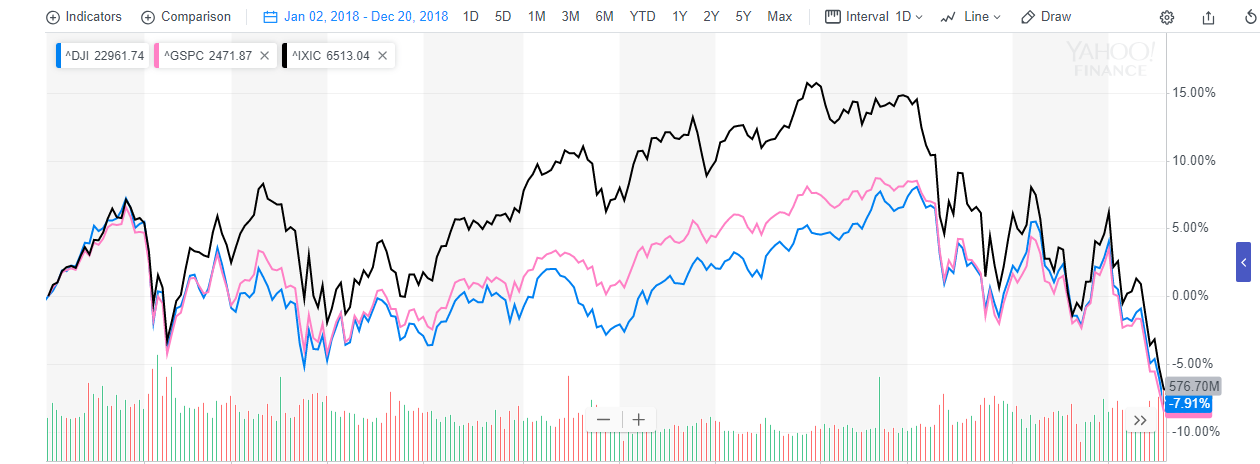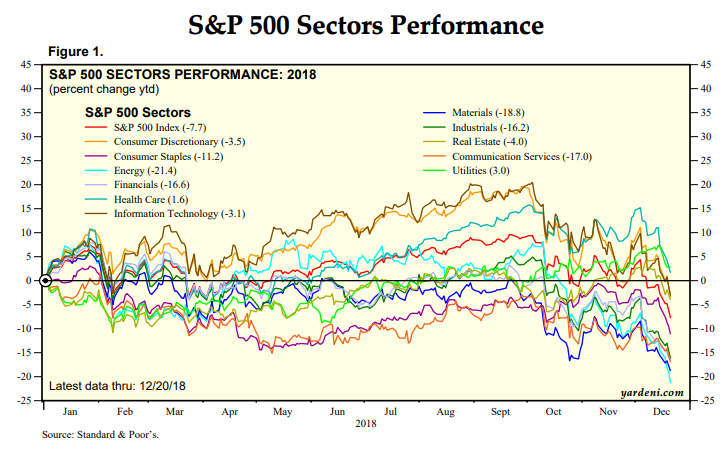The equity markets are in the doldrums, especially when viewed through the lens of the strong gains witnessed in 2016 and 2017. With hardly a week before the close of the year — even with the assistance of a Santa Claus rally — it appears unlikely the major averages could wipe out their losses for the year.
This is how the major averages have fared year-to-date through Dec. 20:
- Dow Industrials: down 7.5 percent.
- S&P 500 Index: down 7.71 percent.
- Nasdaq Composite Index" down 5.4 percent.

Source: Yahoo Finance
After an uneventful first quarter, stocks rose sharply midyear before the October sell-off spooked the markets. The negative sentiment was sustained in November, although the averages carved out modest gains for the month. The sell-off worsened in December, taking them lower for the year.
Broad-Based Weakness
Although the sell-off can safely be termed broad-based, given the across-the-board market weakness, a couple of broader S&P industry classes weathered the downturn.
The worst among the lot were energy, materials, the newly carved out communications sector and financials.
The dollar's strength has hit commodities hard, as most commodities are dollar-denominated. The U.S. dollar Index, which is an index measuring the value of the U.S. dollar against a basket of six top currencies, has gained about 4.3 percent year-to-date. This explains the weakness in the energy and materials spaces.
Crude oil has lost one-quarter of its value amid the dilly-dallying among OPEC members on production cuts, and most base metals as well as precious metals are lower.
With the communications sector now heavily weighted with social media stocks, which were previously part of the tech sector, it's no wonder its losses are more pronounced. In comparison, the IT sector has seen a low-single digit percentage drop.
Notwithstanding monetary policy tightening, financial stocks have come under pressure following the inversion in the yield curve, which has rendered short-term interest rates higher than longer-term rates. Banks, which borrow short-term funds and lend long-term, are seeing their profitability erode due to the inversion.
A general economic slowdown and Sino-American trade tensions are also weighing down the sector.

Source: Yardeni Research
Utility, Health Care Hold Up...Barely
Utilities and health care stocks were the only ones among the 11 sector classes that have notched gains for the year. As of Dec. 20, the two sectors were up 3 percent and 1.6 percent, respectively.
Utilities qualify as defensive stocks, as they assure investors stable dividends and steady earnings irrespective of the phase of the economic cycle and the state of the stock market. Investors gravitate toward these safer bets in times of uncertainty.
Among the broader utility sector, independent power producers and energy traders are standing tall, although the rest of the subsectors, such as water utilities and multi-utilities, are also in the green.
Health care stocks are also seen as a defensive alternative.
Among the subsectors, health care equipment vendors, managed health care and pharma companies have seen strength, while biotech stocks are trading notably lower. Health care services firms have turned in flattish performance.
Apart from safe haven appeal, buoyant earnings, attractive valuation and a regulatory framework that is turning positive for pharma stocks are also cited as reasons for the sector's outperformance.
Stocks are in correction territory thanks to the sell-off seen since October. And it may not be over.
Geopolitics, economics and monetary policy all seem to suggest that the downtrend has legs. Investors now have their task cut out for them: scouting for beaten-down stocks that are fundamentally sound and promise big upside when the overall sentiment improves, or staying invested in defensive stocks that can fetch decent returns even amid further deterioration.
© 2025 Benzinga.com. Benzinga does not provide investment advice. All rights reserved.
Trade confidently with insights and alerts from analyst ratings, free reports and breaking news that affects the stocks you care about.